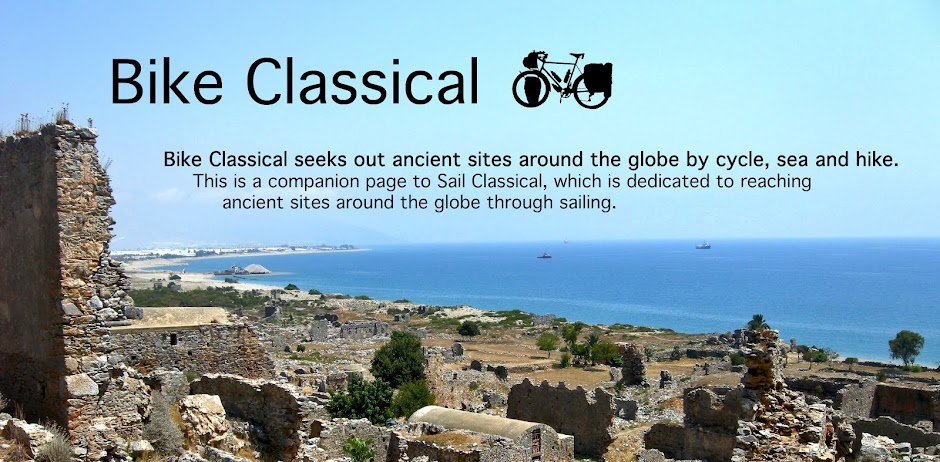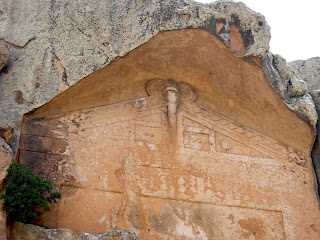Photos by Jack A. Waldron
Rising behind the Ottoman era spring pictured above (or at least, decorated fountain with Ottoman reliefs), is a rock ridge not far from the Aslankaya monument in Doger, that holds some secret of another ancient culture. What is significant with regard to the spring and the cliffs, is that one signifies triumphant, while the other defeat.
Just below and next to the ridge is an interesting subterranean dwelling with a massive entrance door (pictured above and below). The silt has filled in the space leaving only a meter between the ceiling and the floor. Assuming that this space has not yet been excavated, and myself unprepared to go into the darkness, I have little idea as to how this extensive chamber was utilized.
As I approached the cliffs, it became clear that large vaulted rooms were cut into the soft tufa stone, and from my initial impression of the structures I suspected that this was a Byzantine era community (pictured below).
Byzantine culture is visible throughout the Anatolian Plateau for the simple reason that, their is an extensive availability of tufa cliffs as a cheap source of building material. As the Byzantine empire became weaker and poorer, the tufa stone suplemented the rich stone used by the Romans (i.e., marble, granite, etc.). This is not meant however, to imply that the nobles did not use rich building materials for their palaces, summer retreats, and favored religious constructions.
From a distance (in the photo above), you can see the three niches carved into the tufa of the interior of a church that has seen the collapse of a major portion of its structure that is now situated just in front of where I am standing.
You may also see on of the square pillar to the right of the niches, and a tall rectangular niche to the left of three niches, which has a hole at the top exposing more inner chambers.
Many of the Byzantine sites within the ancient Phrygian lands have yet to be properly excavated, and many have been looted over the centuries. Some of the recovered artifacts can be seen at numerous museums throughout Turkey, including these on display at the Aksehir Archeological Museum.
The inner chambers of these monuments (pictured below) have been used over the centuries by sheep and goat herders as dwellings, places of refuge, storage spaces and holding pens for livestock . . . , AND, are still used in many locations for the purposes still today!
Not the sacred golden serving cups of the wealthy churches of the great ancient cities, these cups with their anointed decorative impressions offered promises of redemption to the faithful.
These Byzantine cups are on display at the Aksehir Archeological Museum, and probably originated from the area around Philomelium, which was the ancient name of Aksehir.
Pictured below, the Philomelium necropolis just below the acropolis at Aksehir. The tomb in the photo is Seljuk, if I am not mistaken.
Though the Corinthian capital pictured above appears to be late-Roman to early-Byzantine, many of the stele and sarcophagi from the area are Byzantine (pictured below).
The rural areas controlled by the Byzantines were not able to afford such luxuries to commemorate their deceased. Pictured below, another inner church chamber at the rock enclave near Aslankaya in Doger.
Icons were perhaps carried over from the pagan practice of keeping your gods in hand and near for protection and good blessings. Pictured below, a few artifacts with iconic reliefs are on display at the Aksehir Archeological Museum.
Pictured below, a miniature door that once fit onto a finely decorated sacred relic box or small cabinet on display at the.
The iconography displayed on many christian relics were the source of the great schism between the Western Roman Empire and the Eastern Roman Empire.
This difference in beliefs led to great conflict between the opposing sides; the iconoclasts versus the iconophiles, and was one of the reasons the two side could not reconcile, and come together.
Pictured below, the left side of the church chamber (right side featured above) at the Doger site near Aslankaya. The crucifix reliefs carved between the arches have been outlined in the soot left by the campfires of the transient occupants over the centuries.
Pictured below, a view of the back of the church with light shining through the holes, windows and doors in the cliff face.
Picture below, what appears to be a tomb with two beds for the deceased to be laid to rest. My expertise on this sort of construction is limited, and this may very well have been a dwelling for a family, or for a priest?
Also on display at the Aksehir Archeological museum are some authentic tool artifacts from the Byzantine period. Pictured below, are two oil lamps, a basin, pitcher, and incense holder.
Metal tools would have been prized possessions for any farm family, monk or other of the period, including the needles pictured above, or this pitchfork (pictured below).
Pictured below, more crucifixes left behind by the faithful believers of the christian religion.
What must be the prize possession of the Aksehir Archeological Museum is the relic cabinet pictured below. On the front door, with its keyhole located on the left, is a painting of a golden cup, with what appears to be Jesus rising out from in the chalice.
Could this cabinet have been built for the sole/soul purpose of guarding one of the many fake relics of the time, that were purported to have been used by Jesus, or one of his disciples?
Pictured below, on the front of the crown of the cabinet is painting of the last supper. I am assuming that this is meant to show from where and when the golden cup that was once housed in this cabinet originated.
This cabinet had many human hours put into it, and it was not cheap nor lowed craftsmanship that produced such an exquisite piece.
This cabinet was built to hold something that was thought to be invaluable, but, that in times of crisis could be easily relocated to a safe place. Perhaps that is the reason it has survived over the millennia?
As for the remaining painted panels of the cabinet, I will rely on the help of others to inform us through comments below, as to who and what is represented.
Each painting refers to something specific, of this I am sure; unfortunately, the curators at the Aksehir Archeological Museum are probably not experts in the iconography of Byzantine art (as I am also not), and thus, this information is not offered at the display.
I have tried to order the panel photos as commonsensical as possible, though, it was impossible to take photos of the back of the cabinet, as the display is secured to the wall for protective purposes, and I could not get my camera to view the back.
However, to no fault of the display, I did manage to miss taking close-up photos of the two crown paintings on the right side of the cabinet (pictured below).
This is truly an iconic piece of Byzantine art and history. I hope to learn to the full extent the representations and meaning behind these depictions.
Cheers for your time and patience in reading this post in its entirety. If you have any comments that can help uncover the mystery behind these panels, it would be greatly appreciated.
*All photos and content property of Jack A. Waldron (photos may not be used without written permission)
**If you'd like to help with future postings, please feel free to support them through PATREON:




























































































